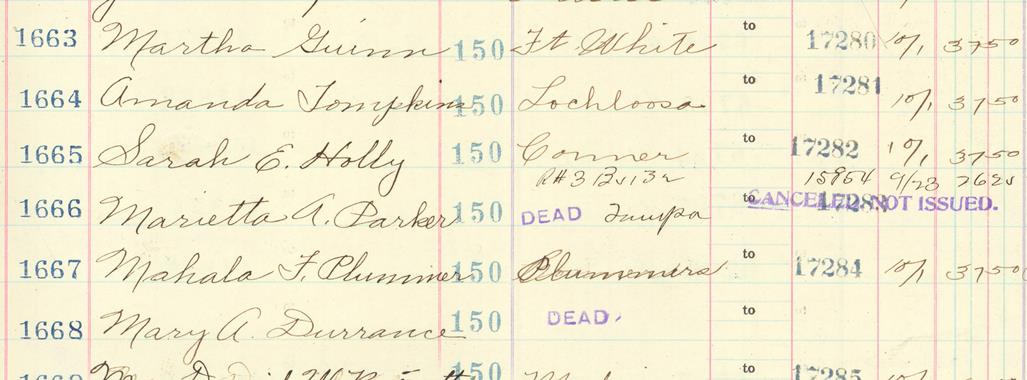Description of previous item
Description of next item
Doing Genealogy with Pension Records
Published March 3, 2015 by Florida Memory
The Confederate Pension Applications are one of the most popular series of historical documents on Florida Memory. They chronicle the efforts of Confederate veterans and their wives to obtain pensions from the State of Florida in the late nineteenth and early twentieth centuries. By law, in order to obtain a pension a veteran or his widow had to provide information about the veteran’s Civil War service, his birth, and proof of a qualifying disability. Widows of Confederate veterans had to provide proof of their marriage. The State Board of Pensions reviewed these applications and approved those that met the proper qualifications.
The applications alone are full of useful information for genealogists and historians, but when used in conjunction with other collections at the State Archives of Florida they can do much more. For example, if you know you have a Civil War veteran or veteran’s widow in your family tree who received a state pension, in many cases you can find out how long the person received that pension, how much they received, and where they lived while they were receiving it. This can be achieved by finding the veteran or widow’s pension application on Florida Memory, then visiting the Archives for a look through the State Comptroller’s records of pension payments (Record Series 678).
Let’s use Floridian Civil War veteran Robert H. Parker as an example. If you search for Robert H. Parker on the Confederate Pension Applications page, here’s what you get:
Sometimes an individual will have multiple application numbers, but as the example above demonstrates, usually only one application will have the best information. In Robert Parker’s case, if we click on the application numbered A01666, we’ll get over a dozen pages of information from his soldier’s pension application, as well as the widow’s application of his wife Marietta.

Page from the Confederate Pension Application file of Robert H. Parker of Hillsborough County. Paperwork from the pension claim of his widow Marietta is also included in the file.
We see from Marietta’s pension claim form that her husband Robert died on October 16, 1914, and that the Pension Board approved her to continue receiving a Confederate pension as his widow. What we can’t tell from this paperwork is how long she continued to receive that pension, or whether she moved after her husband died. That’s where the Comptroller’s records can help!

Volume 24 of the State Comptroller’s record of approved pension claims, 1895-1917 (Series 678, State Archives of Florida).
If you’ll notice in the example search results above, each of the Confederate Pension Applications is identified by a number. In Robert and Marietta Parker’s case, the number is A01666. The “A” in this code simply means the application was approved; the “1666” is the part used across state agencies to identify the pensioner.
The State Archives holds a series of ledgers from the State Comptroller’s office that record each payment made to each pensioner up through 1917. There are separate ledgers for soldiers and widows. The entries in each ledger are sorted by the pension number, so if we know Marietta started receiving a widow’s pension after her husband Robert’s death in 1914, we should be able to track her payments from that time by looking in the “Widow” volumes for entry number “1666.”

Volume 24 of the State Comptroller’s record of approved pension claims, 1895-1917 (Series 678, State Archives of Florida)
And there she is! In the example above, you’re seeing the information recorded for pension payments made on October 1, 1915 by the State Comptroller’s office. For each pensioner, you get the pensioner number, name, pension amount per year, postal address, Comptroller’s warrant number, date the pension was sent, and the amount of this particular payment. The pension payments were generally sent quarterly.
Just from this entry alone, we learn a few helpful bits about Marietta Parker. We know she was living on a rural postal route near Lutz in Hillsborough County in October 1915, and that she was receiving $37.50 every three months. Each ledger page typically covers a year’s worth of payments. Let’s keep following Marietta Parker’s payments to see if anything else helpful turns up.

Volume 26 of the State Comptroller’s record of approved pension claims, 1895-1917 (Series 678, State Archives of Florida)
Going through the Comptroller’s records of payments to Marietta, we learn that she moved to Tampa sometime in the spring of 1916, evidenced by the fact that her postal address changes. Also, when we get to the entry above, we learn that Marietta died sometime during the quarter leading up to the October 1, 1916 payment.
If you happen to be researching an ancestor whose death date or location have been tough to ascertain, these records can be very helpful. Plan a visit to the State Library & Archives soon to have a look. Remember, Series 678 only covers through 1917. If your Civil War veteran ancestor or his widow lived past that time, researching his or her later pension payments will require a different approach.
You might also want to have a look at our Guide to Genealogical Research. It has some helpful hints for getting started with your family history adventure!
Cite This Article
Chicago Manual of Style
(17th Edition)Florida Memory. "Doing Genealogy with Pension Records." Floridiana, 2015. https://www.floridamemory.com/items/show/275769.
MLA
(9th Edition)Florida Memory. "Doing Genealogy with Pension Records." Floridiana, 2015, https://www.floridamemory.com/items/show/275769. Accessed January 1, 2026.
APA
(7th Edition)Florida Memory. (2015, March 3). Doing Genealogy with Pension Records. Floridiana. Retrieved from https://www.floridamemory.com/items/show/275769

 Listen: The Assorted Selections Program
Listen: The Assorted Selections Program